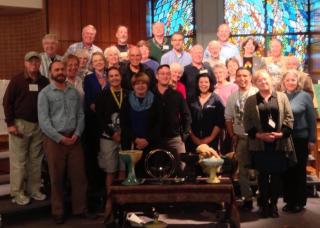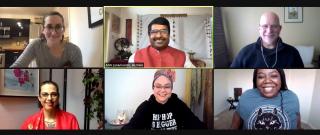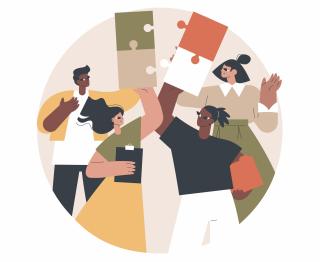Advertisement
At this point, collaboration comes so naturally to the Rev. Bethany Russell-Lowe, the Rev. Tina Squire, and the Rev. Matthew Funke Crary—ministers at Unitarian Universalist Church of Tucson, Arizona; Sky Island Unitarian Universalist Church in Sierra Vista, Arizona; and Mountain Vista Unitarian Universalist Congregation, also in Tucson, respectively—that they inadvertently strayed into a collaborative aside during the interview for this article.
“We’re using prerecorded videos as hymns in our Sunday services,” Russell-Lowe said, referring to videos from past online worship services.
“We’re doing that, too!” Funke Crary exclaimed.
“Cool! I haven’t done that,” Squire replied. “That makes a lot of sense. I could use those videos, too.”

A Baja Four gathering in January 2015.
The ministers’ ease with each other masks the deep, deliberate, and extensive work that undergirds this partnership—one that has been decades in the making. The three congregations—along with Borderlands Unitarian Universalist in Amado, Arizona, which is currently lay-led—make up the Baja Four, a partnership between four small-to-midsized congregations in southern Arizona. The ministers of these congregations had regular lunches together for decades, and the partnership was formalized and given its current name in 2015. But it wasn’t until COVID struck in 2020 that years of casual partnership solidified into something more robust.
Russell-Lowe recalled that it was March 15, 2020, when the UU congregation of Tucson somehow managed to pull its first online service together in 48 hours. “After that, I got home and emailed the three of them on Sunday night: ‘I can’t do this alone.’”
The Baja Four isn’t the only group of small congregations banding together to overcome pandemic woes. The Potomac Partnership comprises three congregations in the Washington, D.C., area: River Road Unitarian Universalist Congregation in Bethesda, Maryland; Cedar Lane Unitarian Universalist Church, also in Bethesda; and Unitarian Universalist Congregation of Fairfax, Virginia. The Potomac Partnership similarly has deep pre-pandemic roots: the three ministers started meeting for lunch regularly about six years ago, and when COVID hit they quickly called on each other for support.
Together, these partnerships, and others like them, helped congregations weather the worst of the pandemic. Now, over two years later and with some semblance of normalcy returning, it would be understandable if they went back to their pre-pandemic status quo—meeting for lunches and organizing joint events and programming, but returning to a somewhat more siloed existence within their individual congregations.
In their interconnectedness, they have found joy, strength, and a more sustainable way forward.
But that’s not the case. Instead, because both groups thoughtfully and intentionally built a strong foundation of trust between their congregations, their partnerships are flourishing. In their interconnectedness, they have found joy, strength, and a more sustainable way forward.
In December 2020, the Baja Four was awarded a grant from the UU Funding Program to support work that would help the congregations expand their partnership and build a shared sense of purpose and group identity. They used some of that grant funding to work with the Rev. Dr. Robin Tanner, who helped the congregations grapple with the meaning of partnership and negotiate around what they ideally wanted from a partnership.
“It wasn’t just like, ‘Oh cool, we’re going to do a partnership,’” said the Rev. Samantha Wilson, former interim minister at Mountain Vista. “It was really clear. Like, what does [partnership] mean? What does it ask of us? And what are we promising?”
The Potomac congregations similarly took time to understand what partnership meant to each of them. Beginning in the fall of 2020, lay leaders from all three congregations came together to conduct what they called the Storytelling Project: a series of deep conversations and interviews about how the congregations might be in partnership together. Based on that work, the group then created a presentation that they shared with their boards and congregations.

An online meeting of the Potomac Partnership.
“The lay leaders were brilliant,” said the Rev. Nancy McDonald Ladd, senior minister at River Road. “They [said] what we need to do first is actually listen to each other. We need to hear each other’s stories about where we think our mission is taking us and what collaboration should be before we build an infrastructure around it.”
With a strong foundation in place, the partnerships have been able to find practical and sustainable solutions to challenges that might otherwise have felt daunting to individual congregations.
“Bigger congregations maybe had enough staff, but our smaller congregations lost volunteers in the pandemic,” said Jamili Omar, director of religious education at Tucson. “And so we [thought], how can we utilize resources to serve the four [congregations], rather than stretching ourselves thin to serve one?”
Omar and her colleagues began working on shared religious education programming in the fall of 2020. By combining forces, they have been able to broaden their offerings to serve the full spectrum of religious education needs at their congregations, from groups for preschoolers and their families to a series on dying with dignity. For congregations that serve only a few members in a certain age band, this shared programming has been crucial.
The Potomac Partnership has also been exploring shared staffing models, with two of their congregations currently sharing a social justice coordinator. They also hope to expand their staff-sharing in the future to streamline some back-office operations, such as finance and communications.
“If we create something that can be nested in one of our congregations but provide that service to all three, that’s a way that we can consolidate our resources and still do the work [without having] to reinvent the wheel,” said the Rev. Abhi Janamanchi, senior minister at Cedar Lane.
“Part of our effort to create a more interconnected and interdependent way of existing is recognizing that Unitarian Universalism is still needed, especially in this time.”
–Rev. Abhi Janamanchi
Beyond these practicalities, the partnerships also offer their congregations space for creativity and joy. After realizing that a number of rituals and worship resources are centered around the four seasons of northern climates, the Baja Four partnership began work on a project called Desert Ritual Year, or DRY. The project aims to gather and create resources inspired by the desert for use in worship, which they will share among their four congregations. In October 2022, the DRY project convened for its first “create day,” where participants thought about the season of fall in their geography, rewriting a fall-themed hymn with desert-inspired lyrics.
That this type of deep collaboration brings many benefits is clear to the ministers of each partnership—so much so that they see interdependence and interconnectedness as the way forward for Unitarian Universalism.
“Part of our effort to create a more interconnected and interdependent way of existing is recognizing that Unitarian Universalism is still needed, especially in this time,” said Janamanchi. “[But] the way we have functioned has kept us both insular and homogenous. And if we are to really live into our pluralistic theology and our vision of building the Beloved Community within, among, and beyond, we need to function differently to embody that more fully.”
